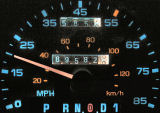Chapter 7
The Fundamental Theorem of Calculus
7.1 Averaging Continuous Functions:
The Definite Integral
7.1.4 Subdivide and Conquer
Our technique for estimating distance using only speedometer readings can be applied to a wide range of problems. This class of problems can be described in the following way: If all the measurements involved have constant values, then there is a simple product formula that gives the answer. Here are some examples:
| distance | `=` rate `times` time. |
| area (of a rectangle) | `=` length `times` width. |
| volume (of a box) | `=` length `times` width `times` thickness. |
| mass | `=` density `times` length `times` width `times` thickness. |
| force | `=` pressure `times` area. |
| momentum | `=` mass `times` velocity. |
As was the case with the speed of our car, we often want to consider problems in which some measurement is not constant. The first step for calculating such product quantities when one or more of the factor measurements varies is what we call subdivide and conquer. If we can subdivide the problem into small pieces in such a way that the simple product formula applies on each piece, then we can add the results on all the pieces to get the answer we are looking for. More typically, we will find that the varying quantity is only approximately constant on each piece, so the simple product formula gives us only an estimate on each piece. We can still add the results on the individual pieces to get an estimate of the total. But to calculate the total exactly, we have to consider finer and finer subdivisions that produce better and better estimates, eventually arriving at a limiting value.
What takes this class of problems out of the reach of arithmetic or algebra and into the realm of calculus is the need to consider successively finer subdivisions. In this respect, the problems we consider in this chapter have something in common with the problem of finding instantaneous rates of change: The solutions to both types of problems require the determination of a limiting value.
 The "something in common" is deeper than that: The distance-from-velocity
problem we consider here is closely related to the velocity-from- distance problem
in Chapter
2. In fact, these problems are as close as the (physical) connection between
the speedometer and odometer. Each of these measuring devices gives enough
information to determine the readings of the other.
The "something in common" is deeper than that: The distance-from-velocity
problem we consider here is closely related to the velocity-from- distance problem
in Chapter
2. In fact, these problems are as close as the (physical) connection between
the speedometer and odometer. Each of these measuring devices gives enough
information to determine the readings of the other.
When we find speeds from measured distances, our procedure is to subtract odometer readings (to find distances) and clock readings (to find elapsed times) and divide the differences. Then we sneak up on the instantaneous speed by taking smaller and smaller time intervals. To go in the other direction — to find distance from measured speeds — we use the opposite procedure: We multiply speeds by elapsed times and add the results. Then we sneak up on the exact distance by using smaller and smaller time intervals.
We already know one way to undo the differentiation process — by antidifferentiation. We have just discovered another way, by multiplying, adding, and finding a limiting value. It should come as no surprise that these two apparently different procedures, both of which have important applications, are closely related. We will find that relationship expressed in the central result of this chapter, the Fundamental Theorem of Calculus.

